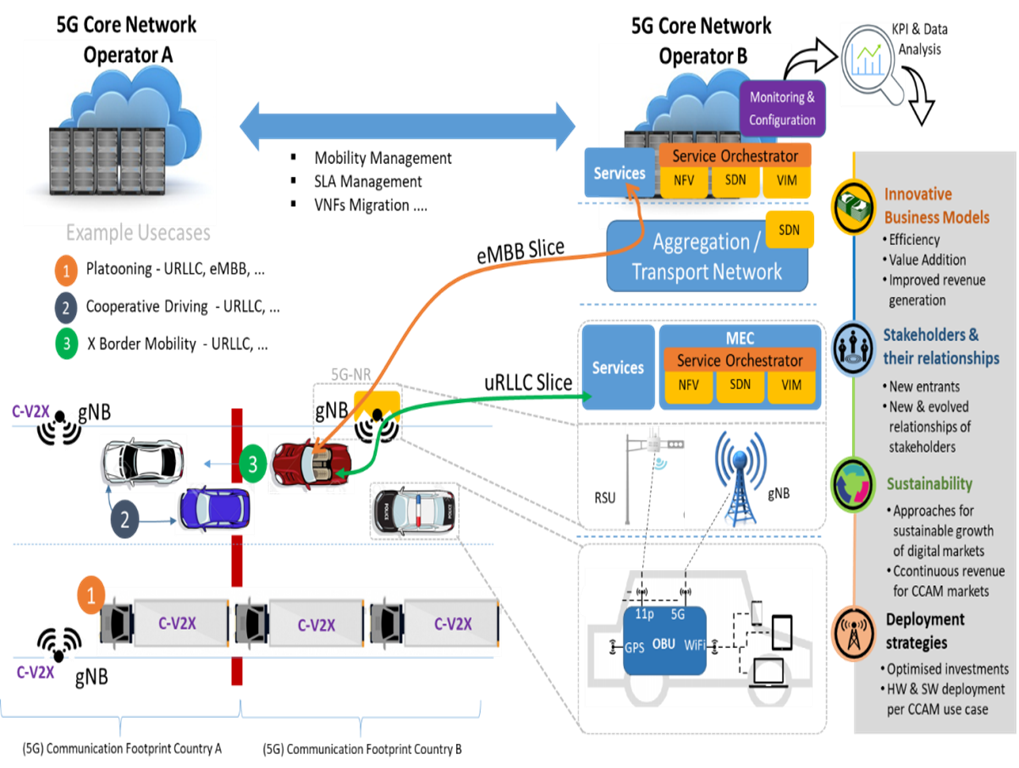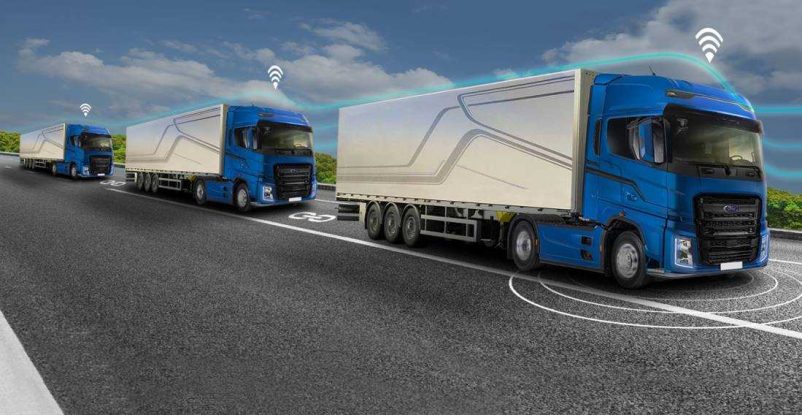Published on 28/01/2022

About the project:
Connected and automated driving will offer solutions to our societal challenges but there remain significant technological and urgent organizational issues to be addressed: that is both fully connecting and automating vehicles. On one hand, the advantage of connecting vehicles is that vehicles gain the capability to communicate and learn from each other’s (and infrastructures’) experience along the road network. New road work, missing marking, dangerous crossings or hidden corners are automatically known to the entire fleet. On the other hand, the advantage of automating vehicles is that vehicles gain the capability to intelligently learn (e.g. to drive better) as other vehicles and infrastructures collect new data. In consequence, vehicles (also infrastructures) become part of a complex vehicular ecosystem where communications between vehicles, infrastructures and the cloud are essential. Unlocking the true potential of automated driving then requires a reliable, robust and pervasive wireless network: 5G.
From GSM to 4G, all generations of mobile networks features have been mainly defined to address the needs of mobile devices users. Those features were also matching other needs including Machine Type Communications. However, 5G targets significantly higher performances, which will not only address new needs but also create breakthrough of many industries, including automotive. 5G will provide new radio access technologies and core network evolutions delivering enhanced mobile broadband services, therefore playing a key role for digitizing the European industry. Moreover, compared to 4G, 5G is expected to provide significant improvements in many cellular network KPIs, such as 1000 times higher data volume and device density, 10 times lower energy consumption or ultra-low end-to-end latency
The aim of 5G-MOBIX is to match the benefits of 5G technology with advanced Cooperative, Connected and Automated Mobility (CCAM) use cases in order to validate the viability of the technology to bring automated driving to the next level of vehicle automation (SAE L4 and above). 5G-MOBIX’s vision is to enable innovative, previously unfeasible, automated driving applications, both from a technical as well as from a business perspective.
5G-MOBIX capitalizes on state-of-the-art road and network infrastructures and automated vehicles, leading expertise from the automotive and telecom industries, the research community, and strategic plans by public authorities. As such, 5G-MOBIX will deliver a complete evaluation and recommendation of core innovative 5G technologies enabling CCAM by means of upgrading and testing automated vehicle functionalities along TWO cross-border corridors and SIX urban trial sites. These multiple eight sites will allow 5G-MOBIX to face and tackle all conditions of vehicular traffic, network coverage, service demand, as well as the inherently distinct legal, business and social local aspects. In brief, 5G-MOBIX aims at demonstrating the viability of 5G-augmented complex highly automated driving scenarios, as well as 5G suitability to create new business models and opportunities, in the domain of automated mobility.

Figure 1: 5G-MOBIX concept figure
Objectives
5G-MOBIX has the following high-level objectives
- Objective 1: Formulate a comprehensive set of 5G technological requirements for advanced CCAM relevant for the automotive, telecom, IT and services industries, and for R&D and public authorities.
- Objective 2: Establish corridors to evaluate complementary 5G technologies and advanced CCAM in both highway cross-border and urban mobility scenarios under all conditions.
- Objective 3: Analyze costs and benefits of dedicated and validated 5G architecture and CCAM to justify commercially the proposed recommendations.
- Objective 4: Explore and asses new business opportunities for CCAM with 5G.
- Objective 5: Provide 5G deployment scenarios and recommendations to drive CCAM adoption and effective implementations from business and policy perspectives.
- Objective 6: Sustain standardization and spectrum allocation by actively contributing to the discourse.
- Objective 7: Scale up and replicate for a global adoption of the 5G for CCAM.
Use cases/verticals
5G-MOBIX will instantiate a multitude of different vehicular use cases to address the full spectrum of CCAM functionality and to test the current limits of the state of the art systems and the expected benefits of the 5G connectivity. These use cases will be distributed across the two cross-border corridors and the six local trial sites of 5G-MOBIX. More specifically trials will be executed in:
- Greece – Turkey borders (GR-TR cross-border corridor)
- Spain – Portugal borders (SP-PT cross-border corridor)
- Finland (Espoo trial site)
- Germany (Berlin & Stuttgart trial sites)
- France (Versailles trial site)
- The Netherlands (Eindhoven trial site)
- China (Jinan trial site)
- South Korea (Yeonggwang trial site)
The different corridors and trial sites will focus on complementary aspects of CCAM functionality in an effort to cover all relevant scenarios from more simplistic to the more challenging and to provide a thorough evaluation of the 5G performance in different automotive scenarios. Partial overlap of scenarios between the cross-border corridors and the local trials has been envisioned in order to better develop certain scenarios and technologies under more controlled environments (local trials) and then test them on a much more challenging environment (cross-border). Table 1 below indicates the high level use cases that will be tested in each of the project’s corridors / trials.
Table 1: 5G-MOBIX High level use cases per corridor / trial

WINGS Involvement
WINGS has undertaken the role of 5G-MOBIX’s Technical Manager (TM) and as such has a significant impact on the project outcome, since WINGS will be responsible for the delivery of excellent technological solutions, the coordination among the technical WPs to ensure the delivery of a smoothly operating end to end system and to guarantee the successful completion of the project’s technological objectives. Besides the role of TM, WINGS is also the WP3 leader, leading the activities of technology development, integration and roll-out to the trial sites as well as the Task 2.2 leader coordinating the 5G architecture and technology specifications of each trial site. Apart from the leading and management roles, WINGS will also be very active in the technical parts of the project and more specifically in the requirements analysis and specification definition of the GR-TR networks, the technology development of integration of assisted driving components for the VRU protection and secure border-crossing use cases of the GR-TR pilot. More specifically, the high-level activities of WINGS include:
- Technical management and WP3 & T2.2 leadership and coordination among partners
- Greek 5G network requirements analysis and specification definition for serving advanced CCAM use cases
- Contribution to the GR-TR pilot 5G network architecture & interworking definition
- Development and integration of assisted-driving functionality based on AI/ML technologies for the WINGS smart cities platform
- Development and integration of advanced data fusion and predictive analytics functionalities for the automotive environment.
- KPI analysis and scenario adjustment for the GR-TR use cases
- Dissemination of all relevant results to relevant fora and 5G / automotive industry events.
Greece – Turkey cross-border corridor
The Greece – Turkey cross-border corridor is located in the South-Eastern borders of Europe providing a strategic geo-political environment (rigorous border checks, border gates, customs, etc.).
These unique conditions make it a fruitful testing ground for the operation of CCAM use cases at EU border conditions, and how the involved stakeholders should adapt to accommodate such functionality.

As these borders are main arteries of trade, truck platooning use cases are of extreme importance.
The use of advanced 5G enabled vertical technologies (IoT, wearables, AI) on top of such automated driving scenarios is crucial to facilitate traffic, operations and border management.
The participation of the two largest MNOs in Greece and Turkey respectively and the guaranteed cell-edge conditions to be created at the border, will provide important insights into the limits of coverage and performance that can be expected by 5G technology and the level of support provided for CCAM use cases.
[source]
WINGS prospects/exploitation
As part of its 5G-MOBIX activities, WINGS will extend its knowledge base regarding the transportation (automotive) vertical of 5G as well as the application of Big Data predictive analytics techniques in automotive environments. Moreover, the software tools to be developed during the project to accommodate the trials (e.g. resource allocation and balancing algorithms, Data fusion for VRU protection, KPI assessment and pre / post processing, automotive behavior analytics algorithms, predictive algorithm for transport applications, etc.) will allow WINGS to extend its own vertical platforms with enhanced capabilities, hence improving their market potential.
Awards & demonstration video
Demonstration on Assisted zero-touch truck-border-crossing & increased cooperative awareness has received the Best Booth Award, as part of the “EU 5G Cross Border Corridor Projects by 5G-MOBIX, 5G-CARMEN, 5G-CroCo” booth at EuCNC 2019, in Valencia.

Website: https://www.5g-mobix.com
Framework: H2020/5GPPP Phase 3
Duration:
![]() This project has received funding from the Horizon 2020 programme under grant agreement No 825496
This project has received funding from the Horizon 2020 programme under grant agreement No 825496

